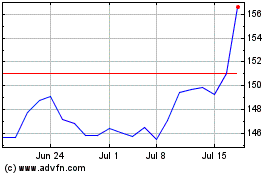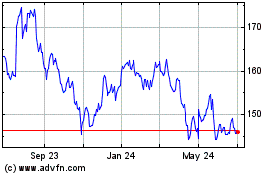By Sara Randazzo and Jared S. Hopkins
An Oklahoma judge ordered Johnson & Johnson to pay $572
million for contributing to the state's opioid-addiction crisis, a
verdict that could signal further findings of liability for drug
companies as similar cases wind through courts across the
country.
More than 2,000 cases brought by state and local municipalities
seek to hold drug makers, retail pharmacy chains and distributors
accountable for widespread opioid abuse that began gaining public
attention in the early 2000s. That flood of litigation coincides
with intensifying efforts by the Justice Department to use data to
investigate over-prescription of opioids by doctors.
Oklahoma's case was the first to go to trial and became focused
solely on Johnson & Johnson after two other drugmakers settled
their claims.
In a widely anticipated ruling Monday, Oklahoma state court
judge Thad Balkman said the state proved Johnson & Johnson
launched a misleading marketing campaign to convince the public
that opioids posed little addiction risk and were appropriate to
treat a wide range of chronic pain.
"The increase in opioid addiction and overdose deaths following
the parallel increase in opioid sales in Oklahoma was not a
coincidence," the judge wrote. From 1994 to 2006, prescription
opioid sales increased fourfold, the judge said in the ruling. In
2015, more than 326 million opioid pills were dispensed in the
state, enough for every adult Oklahoman to have 110 pills.
Judge Balkman ordered Johnson & Johnson to pay for just one
year of abatement, not the 20 or more years the state requested. He
said the $572 million should go toward addiction treatment and
overdose prevention services, programs aimed at managing pain
without opioids and other resources.
Johnson & Johnson said it would appeal the judgment and that
the judge's conclusions disregards the company's compliance with
federal and state laws.
"The company here made medicines that are essential for patients
who suffer from debilitating harm," Sabrina Strong, an attorney for
Johnson & Johnson, said after the ruling. "They did it
responsibly."
Oklahoma Attorney General Mike Hunter commended the ruling,
calling it "a major victory for the state of Oklahoma, the nation
and everyone who has lost a loved one because of an opioid
overdose."
Over the course of the seven-week trial, attorneys for Oklahoma
argued that Johnson & Johnson is liable not only for two opioid
drugs it sold -- the fentanyl patch Duragesic and tapentadol pill
Nucynta -- but also because it owned two companies that supplied
the active pharmaceutical ingredients and narcotic raw materials to
other drugmakers for their own opioid painkillers.
The judge said in the ruling that Johnson & Johnson's
misleading marketing included unbranded campaigns jointly developed
with other companies that suggested pain was undertreated and that
higher amounts of opioid prescriptions were the solution. The state
said the company's actions created a "public nuisance" and asked
the judge to award as much as $17 billion to abate the costs of the
crisis.
Analysts followed the Oklahoma trial closely for signs of what
might happen in the broader opioid litigation. Attention will turn
next to Cleveland, where two counties are set to go to trial in
October against an array of drugmakers and distributors. That trial
is serving as a bellwether for hundreds of others brought by cities
and counties that have been consolidated in federal court in Ohio
before U.S. District Judge Dan Polster.
The verdict could put pressure on settlement talks in the rest
of the opioid cases. Judge Polster has pushed the parties to settle
while allowing the October case to head to trial. Complicating
settlement talks is tension between state attorneys general, which
want to maximize recoveries from cases they have filed in state
courts, and the many cities and counties pressing cases in federal
court.
Ashtyn Evans, an analyst at Edward Jones & Co., said damages
were expected to be under $1 billion in the Oklahoma case and
investors were responding favorably to that. "A multibillion dollar
ruling would have been a worst-case scenario," she said.
David Maris, an analyst at Wells Fargo & Co. who covers the
pharmaceutical industry, said he expects companies fighting the
cases consolidated in Ohio will be more motivated to reach a
settlement. The $572 million might be a small amount to a company
of Johnson & Johnson's size, he said, but could be onerous for
smaller companies with larger market shares and more
liabilities.
"There's no manufacturer that's high-fiving their lawyers after
today," Mr. Maris said.
University of Connecticut School of Law professor Alexandra
Lahav cautioned against reading too much into Judge Balkman's
ruling as it pertains to the Ohio litigation, given how public
nuisance laws -- on which the Oklahoma case hinged exclusively --
vary among states.
Traditionally used in property disputes, state attorneys general
are increasingly using such laws in cases against private
industries. A North Dakota judge in March dismissed a case brought
by that state's attorney general against Purdue Pharma, citing the
misapplication of public nuisance laws.
"This is one small data point in a much larger legal picture,"
Ms. Lahav said of Monday's decision.
More than 6,000 Oklahomans have died from opioid abuse since
2000, according to the state. Nationwide, there were nearly 400,000
opioid overdose deaths between 1999 and 2017, federal data
shows.
The judgment surpasses the settlements two other companies
reached in the run-up to trial. OxyContin-maker Purdue Pharma LP
and its owners, the Sackler family, agreed to pay $270 million,
much of it to fund an opioid-addiction research center. Teva
Pharmaceutical Industries Ltd. agreed to an $85 million deal.
Johnson & Johnson argued during the trial that its drugs
accounted for a fraction of those taken in Oklahoma and that an
influx of illegal heroin and fentanyl were the real culprits in
overdose deaths.
From 2006 to 2012, Johnson & Johnson's products represented
8% of the market for fentanyl patches and pouches bought by U.S.
pharmacies, according to a Wall Street Journal analysis of Drug
Enforcement Administration data. The company represented around
one-quarter of 1% of the market for prescription opioid pills in
that period, the data shows.
The company still makes Duragesic but sold its interests in
Nucynta in 2015 and exited the opioid-ingredients businesses by
2016.
Shares for Johnson & Johnson and other defendant companies
were trading up slightly in after-market trading following the
judgement before losing some of their gains.
Brad Beckworth, a Texas attorney hired to represent the Oklahoma
attorney general's office in the two-year-old case, said the
verdict shows that the opioid crisis is about more than Purdue,
which has drawn the most attention for its role in marketing
OxyContin for wide-ranging pain. "This crisis didn't occur based on
one person or one company," Mr. Beckworth said.
As Johnson & Johnson continues to battle the opioid cases,
it also faces thousands of lawsuits alleging harms from its
signature baby powder, pelvic mesh and hip devices as well as a
handful of pharmaceutical products.
--Joseph Walker contributed to this article.
Write to Sara Randazzo at sara.randazzo@wsj.com
(END) Dow Jones Newswires
August 26, 2019 19:20 ET (23:20 GMT)
Copyright (c) 2019 Dow Jones & Company, Inc.
Johnson and Johnson (NYSE:JNJ)
Historical Stock Chart
From Jan 2025 to Feb 2025

Johnson and Johnson (NYSE:JNJ)
Historical Stock Chart
From Feb 2024 to Feb 2025
